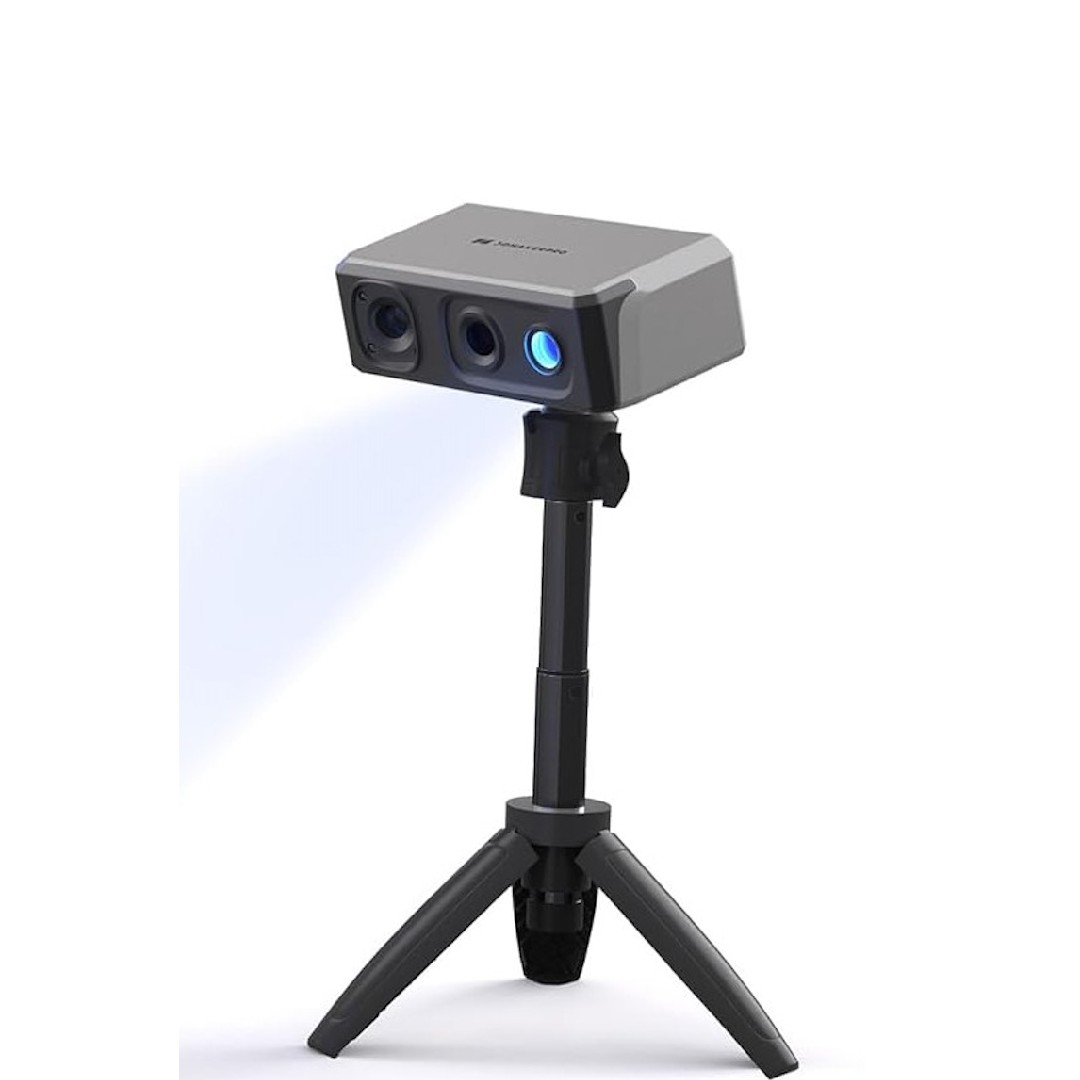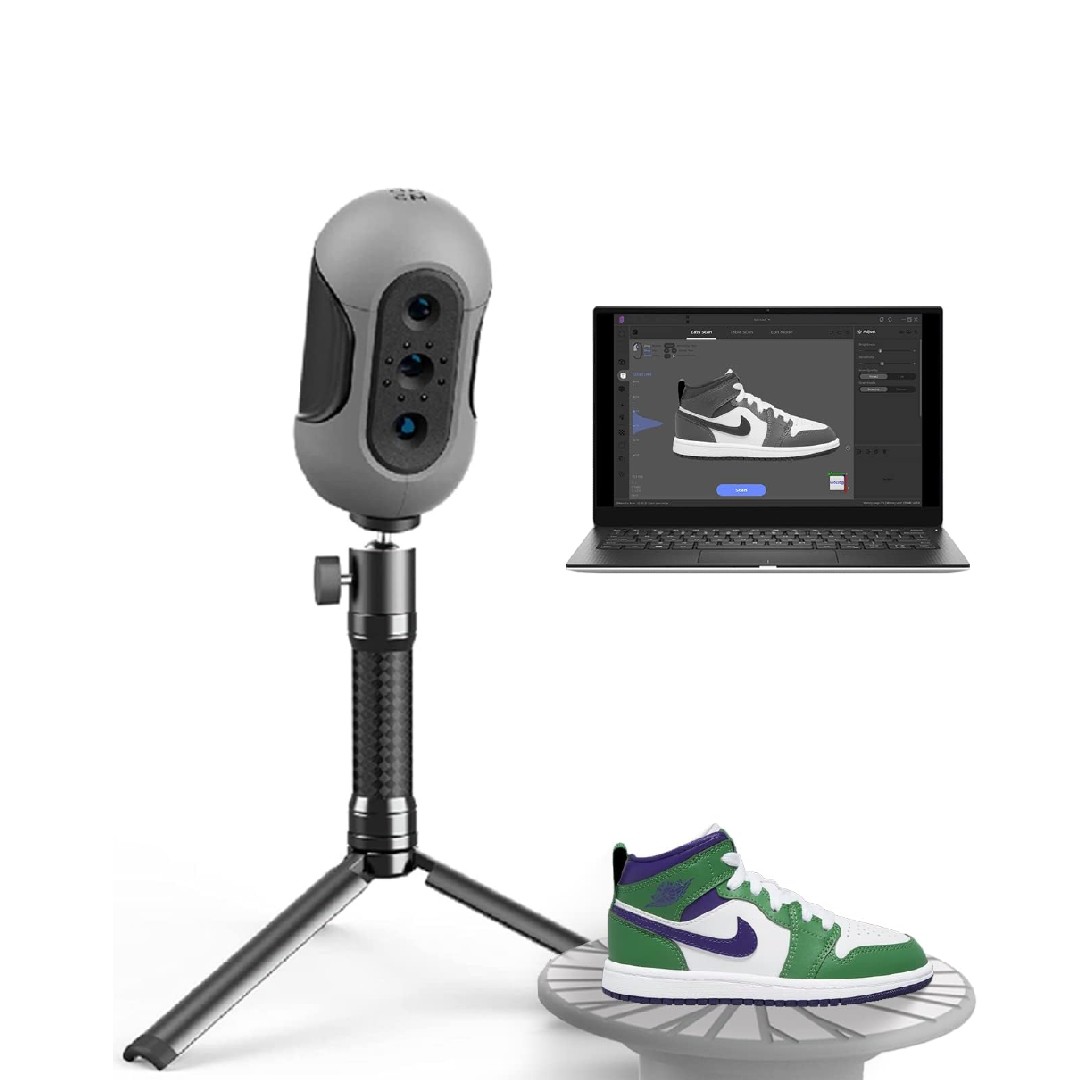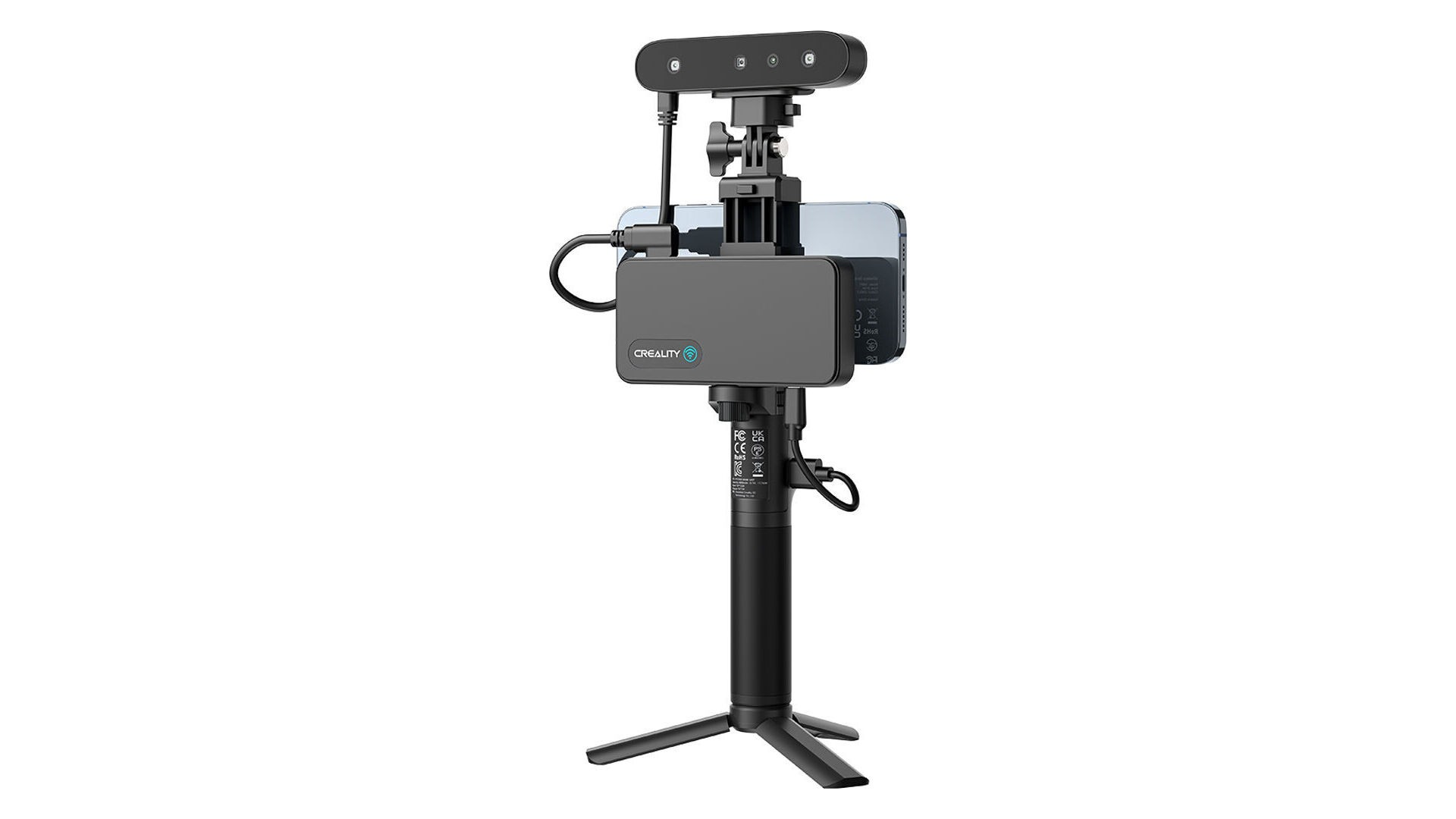The best 3D scanner to create digital models from real-world objects
Scan real-world objects and turn them into digital models, using the best 3D scanners.

With one of the best 3D scanners, you can turn real-world objects in digital models. Be they vegetable, animal or mineral, you simply pass your 3D scanner over the object, and the software converts it into a model that can be turned into a work of art, animated, analysed scientifically, or even recreated as a physical model using one of the best 3D printers.
Of course, it is a little more complex than that. But in simple terms, a 3D scanner uses lights or lasers to illuminate your subject. By controlling the light and positioning of the subject, you're able to take precise measurements, and not rely on software ‘guesses’ as to where the 3D positions triangulate.
In this article, we'll point you toward the best 3D scanners available today, which cover a range of budgets and support a number of different purposes.

Tom May is a freelance writer and editor specializing in art, photography, design and travel. He has been editor of Professional Photography magazine, associate editor at Creative Bloq, and deputy editor at net magazine. He has also worked for a wide range of mainstream titles including The Sun, Radio Times, NME, T3, Heat, Company and Bella.
Our top picks

Revopoint’s MIRACO is our pick as the best 3D scanner on the market today. Whether capturing small details or larger surface areas, its precision of 0.05mm ensures professional-quality results.
Read more below

Light enough for one-handed use, this is a popular choice of sub-$1000 3D scanner for the newbie or enthusiast. It's great for human subjects too, and offers accurate color scanning.
Read more below

This more affordable 3D scanner offers a lightweight, compact design (just 105g), impressive 0.16mm accuracy and the anti-shake technology and intuitive software make it easy to use.
Read more below

With a single-frame precision of 0.01mm, this outshines many consumer-grade devices. Weighing only 254g, it's highly portable, allowing you to move around objects with ease.
Read more below

The only consumer 3D scanner that uses highly accurate blue laser technology, the CR-Scan Raptor enables you to capture 3D scans with a great deal of fidelity and detail.
Read more below

By building this 3D scanner into a fold-closed housing, Matter and Form have made it both portable and robust. It's also supplied with four interchangeable world power plugs.
Read more below
See the next products

While this scanner's 0.2mm accuracy falls short of higher-end models, this model's low price, portability, and ease of use make it an appealing option for medium-sized objects.
Read more below

The 3DMakerPro Mole 3D Scanner is a midrange device that comes with several useful accessories, as well as single-frame accuracy of 0.05mm and a user-friendly experience.
Read more below
The best 3D scanners
Why you can trust Digital Camera World
Best 3D scanner overall

1. Revopoint MIRACO
Specifications
Reasons to buy
Reasons to avoid
Revopoint’s MIRACO is our pick as the best 3D scanner on the market today. Unlike many traditional scanners, which require an external computer, the MIRACO offers onboard processing through its integrated software and a 2K AMOLED touch-sensitive screen, making it incredibly convenient for professionals on the go.
Weighing just 750g, it's nice and light, enabling prolonged use without strain. Its flip-out screen and two-handed grip further enhance usability, making scanning both ergonomic and efficient. It's capable of capturing objects across a wide range of sizes, thanks its quad-depth camera and structured infrared light system, which can be switched between modes mid-scan. Whether capturing minute details or larger surface areas, its precision of 0.05mm ensures professional-grade results.
In terms of color and texture, the scanner excels too, thanks to its 48-megapixel RGB camera, allowing for seamless integration of mesh and texture data. It also offers features like a graph to maintain optimal scanning distance and two shooting modes—single-shot and continuous. These tools simplify the scanning process, making it more accessible to users with varying levels of experience.
All this makes it expensive, and there are more affordable options below. But if you have the cash to spare, this scanner's unparalleled accuracy, advanced features, and streamlined workflow make it a a top-tier solution.
Best 3D scanner for ease of use

2. Shining 3D Einstar
Specifications
Reasons to buy
Reasons to avoid
A popular tracker among enthusiasts for its sub-$1000 price tag and relative ease of use, the Shining 3D Einstar 3D scanner is definitely one to consider. A fairly slim device weighing about half a kilo, the Einstar is nimble enough to be used one-handed – though of course you can always set it up on a tripod and place your subject on a turntable, if you prefer.
A fairly slick user interface makes the process of 3D scanning pretty simple and efficient – even if the initial setup can be a headache as you get your head around the software. Also, the Infrared VCSEL is safe to use on human faces with no danger to eyes, so this is an ideal option for scanning human subjects. It works well on dark reflective surfaces too, which can confuse some scanning systems.
Best value 3D scanner

3. Creality CR-Scan Ferret Pro
Specifications
Reasons to buy
Reasons to avoid
The Creality CR-Scan Ferret Pro has a lightweight, compact design (just 105g) makes it incredibly easy to handle and transport. Providing an impressive 0.16mm accuracy, it excels at capturing intricate details. You get Wi-Fi 6 integration, enabling quick data transfer to smartphones or PCs. And the anti-shake tracking technology and the intuitive Creality Scan software make it easy to use in practice.
Setting up the Ferret Pro is straightforward, as it's compatible with Windows, macOS, Android, and iOS. The rechargeable handheld handle delivers 2.5 hours of battery life, enough for extended scanning sessions. However, it’s best to reserve the battery for scanning and handle file processing while plugged in to conserve power.
While lighting plays a critical role in achieving high-quality scans, the scanner’s ability to adapt to different geometries and textures ensures reliable results with practice. Its innovative features, including visual tracking, customizable scanning modes, and easy-to-use software, make it excellent value for the price.
Best 3D scanner for beginners
4. 3DMakerPro Seal 3D Scanner
Specifications
Reasons to buy
Reasons to avoid
With a remarkable single-frame precision of 0.01mm, the 3DMakerPro Seal 3D Scanner outshines many consumer-grade devices. Weighing only 254 grams, it's is lightweight and highly portable, allowing you to move around objects with ease. While its plastic front panel raises durability concerns, its compact build makes it practical for tight spaces.
The scanner uses USB-A for connectivity and pairs seamlessly with JMStudio software. While there’s no on-device control, the software interface simplifies the process, providing real-time feedback and frame counts. The 24-bit color capture capability ensures accurate texture replication, and its CMOS sensor applies data in real time, removing the need for additional workflows.
Despite its low frame rate, requiring slower movements during scanning, the Seal excels in accuracy and color fidelity. It's an excellent choice for beginners and hobbyists, offering professional results without breaking the bank, though additional accessories may be necessary for optimal performance.
Best blue laser 3D scanner

5. Creality CR-Scan Raptor
Specifications
Reasons to buy
Reasons to avoid
This is the only consumer 3D scanner on the market right now that uses highly accurate blue-laser technology. So while it's fairly expensive by the standards of this list, it's also fairly cheap in comparison to the normal prices you'd have to pay to get a blue laser scanner. Once you get it working, the tech really does give you an impressive level of detail and accuracy in your scans.
The software requires a fair amount of RAM to run – you'll need a decently high-spec computer to handle it. Also, early adopters have reported some trouble getting the software to work, with crashes and tracking errors – this is hopefully something that can be corrected with updates. But it's not a ruinous issue, and the level of detail you get from the blue-laser tech really is next level.
Best 3D scanner for travel
6. Matter and Form 3D Scanner V2
Specifications
Reasons to buy
Reasons to avoid
Off on your travels? Here's a 3D scanner you can carry anywhere, easily and safely. By building this 3D scanner into a fold-closed housing, Matter and Form have made it both portable and robust. Inside that briefcase you can safely transport a laser-based scanner, and it's supplied with four interchangeable world power plugs.
If you’re accustomed to working with large or heavy models, the 3kg (6.6lb) limit may be an issue. But this system is well suited to smaller subjects and the MFStudio software (a download) is more than capable of generating full watertight meshes, with color surfaces, which can be opened in Blender, Max, Autodesk Maya or exported for 3D printing.
Regular 3D printers will appreciate the high-speed scan mode to test the ‘scannability’ of possible subjects before lights are adjusted and powder and other treatments are applied. Plus it's both Mac and Windows compatible.
Best cheap 3D scanner
7. Revopoint INSPIRE 3D Scanner
Specifications
Reasons to buy
Reasons to avoid
The Revopoint INSPIRE is a great entry-level 3D scanner, ideal for hobbyists and newcomers. Its affordable price, portability, and ease of use make it an appealing option for scanning medium-sized objects. While its 0.2mm accuracy falls short of higher-end models, it’s sufficient for most basic projects.
With a scanning speed of 14-18fps and simple setup, it’s perfect for beginners. The included turntable and tripod add value, though the lack of a carry case and lower precision require some trade-offs. Overall, it’s a solid and budget-friendly introduction to 3D scanning.
Best 3D scanner with accessories

8. 3DMakerPro Mole 3D Scanner
Specifications
Reasons to buy
Reasons to avoid
The 3DMakerPro Mole 3D Scanner is midrange device that comes with several useful accessories: a carry case made of ABS plastic with foam inserts, a carbon fiber tripod, a turntable with a USB power cable and a split power cable. And it offers robust features at a budget-friendly price.
With single-frame accuracy of 0.05mm, it caters to 3D printing, reverse engineering, and hobbyist needs. Its ergonomic design makes scanning comfortable, although mounting the tripod requires an additional grip, adding slight bulk. Easy setup and JMStudio software provide a user-friendly experience. And while it's slower than some at 10fps, it compensates with solid tracking and anti-shake technology. Color scanning is possible with an optional kit. And overall this is good choice for hobbyists and professionals seeking reliable, affordable performance.
FAQs
What is a 3D scanner?
A 3D scanner is a device that captures the shape of a real-world object or environment to create a digital 3D model. It's like a high-tech camera that takes pictures in three dimensions, capturing the depth and contours of an object, rather than just a flat image.
How does 3D scanning work?
There are two distinct approaches to 3D scanning. The first involves moving a camera, smartphone or drone around your subject to create 3D triangulation points, using software such as display.land. While this approach doesn't require new equipment, it's not the most accurate.
The second approach involves use of dedicated 3D scanners, which are the devices we looking at the article above.
When you’re scanning a photo, the main job is capturing the color; it’s possible to get the 3D shape without any such tone at all depending on the device, so bear that in mind. (Game designers may not mind this, but retailers will certainly want accurate colors, so that their website visitors can rotate the product and consider it from every angle.)
That said, there's still a degree of imperfection in a digital scan. Just as a photo scanner has a limited resolution, there will be a limited gap between each laser trace on the outside of the subject. It’s useful to find software which can fill these gaps, creating ‘closed models’, though there might be some loss in surface detail. Repairing the mesh will almost certainly need a little hands-on activity, just like photo editing.
What is 3D scanning used for?
3D scanning has an almost endless variety of applications. Firstly, it's used in the entertainment industry to capture actors' performances, props, and real-world objects for use in animation and visual effects production for movies, TV and games. In a similar way, it can be used by artists to capture physical sculptures or objects and transform them into digital models.
Industrial designers use 3D scanning to capture real-world objects or environments as a reference for creating new products. It's used by cultural heritage institutions, museums, and archeologists use 3D scanning to digitally preserve artifacts, historical sites, and monuments. And it's also increasingly used within medical fields for purposes such as prosthetics, orthotics, and dental applications.
How to choose a 3D scanner
The right 3D scanner for you will depend on a number of factors. First decide how large a scanning area you're likely to need. Secondly, consider what level of accuracy and resolution you're going for. (The higher you need, the more you're likely to pay so there may be a compromise needed here). Thirdly, consider whether a handheld or stationary scanner is more likely to fit your needs. Finally, evaluate the scanner's compatibility with specific materials and object sizes, ensuring it suits your intended applications.
How we test 3D scanners
To test 3D scanners, we don't just consider technical information but also carefully consider what scenarios each 3D scanner could be used for. We test each model to assess how useful it's likely to be in practice, taking into account factors such as the size of objects it can scan, how long it takes to scan, how accurate the scans are, how portable it is, and what operating systems it's compatible with. For more details, see our article on how we test and review.
More buying guides:
Best film scanners
Best scanner for documents & photos
The best large format printer
The best camera deals, reviews, product advice, and unmissable photography news, direct to your inbox!
Tom May is a freelance writer and editor specializing in art, photography, design and travel. He has been editor of Professional Photography magazine, associate editor at Creative Bloq, and deputy editor at net magazine. He has also worked for a wide range of mainstream titles including The Sun, Radio Times, NME, T3, Heat, Company and Bella.
- Adam JuniperManaging Editor



